Mental
In 1873 the Middlesex County Council (MCC) purchased Hundred Acres Farm (also known as Freedown) for £10,000 in order to build its third mental asylum.
The Banstead Asylum opened in 1877 with accommodation for 1,700 patients (615 males and 1075 females). Each block, which housed 160 patients, was designated by a letter: Block A was the female infirmary and B-F blocks contained female patients, as did Block L (with 120 beds). Block H was the male infirmary, while Blocks J, K and M housed male patients.
The Asylum was almost self-sufficient, with its own farm and workshops, and had its own gasworks. Coal and other goods were delivered via a paved cart-track on the edge of The Downs.
In 1881 another two blocks - one for males and one for females - were added. Each contained 78 beds. In 1882 the MCC bought another 17.5 acreas at the rear of the site for £3,500. In 1885 another block for 120 patients was built and various alterations were made to the Asylum.In 1889 control of the Asylum was transferred to the newly formed LCC.
In 1892 spur blocks were added to two ward blocks, providing another 51 beds. Temporary buildings (iron huts) to house 300 male patients were erected in 1895; these were replaced by permanent buildings in 1904. Between 1898 and 1907 additional day rooms were provided in four blocks.
In 1912 the LCC purchased the 83-acre Fairlawn Farm for £4,000. The Banstead Asylum then had 200 acres of land, 130 of which were used for farming. In 1918 it was renamed the Banstead Mental Hospital.
A Nurses' Home was built in 1931, which released accommodation in the main building which had been used for staff quarters, and this became a ward for 41 female patients. In 1932 an Admission Villa opened. This had two wings, one for 50 female patients and the other for 50 males.
In 1937 the word 'Mental' was dropped from its name and the Hospital became simply the Banstead Hospital.
By 1939, at the outbreak of WW2, the Hospital had 2,687 beds (1180 for males and 1507 for females). Five wards were taken over for use as an Emergency Hospital. In 1940 the Emergency Hospital closed and the unit was taken over as a military hospital. The 294 civilian mental patients were transferred or discharged and replaced by 400 service personnel suffering from various forms of mental disorder.
During the war a small detached villa with 14 beds, used by convalescent male patients, was destroyed by bombs (it was never replaced).
In 1948, when it had 2,554 beds, the Hospital joined the NHS under the control of the Banstead Group Hospital Management Committee, part of the South West Metropolitan Regional Hospital Board. The Hospital buildings, post-war, were seen as old-fashioned and in need of modernisation and redecoration. Some wards had closed, but 21 beds were re-opened for TB patients.
The military unit withdrew at the end of 1950. At this time the Hospital had 2599 beds. In 1951 the TB ward became the Regional TB Unit with 38 beds, treating male patients with psychiatric disorders who had contracted TB. The female convalescent villa with 20 beds became the Male Nurses' Home in 1952. At this time, excluding three vacant wards, the Hospital had 2,259 beds (813 male and 1446 female), but 2,371 actual patients (855 males and 1516 females). Fourteen wards had been modernised and re-equipped, with premises for a patients' club, a library, reading room and a canteen. The Hospital entrance and the reception area and offices were improved. The X-ray apparatus was replaced and an internal telephone system installed.
Treatments available at this time were leucotomy, deep insulin coma and ECT. In 1953 a new department - Clinical Psychology - was established. Social therapy and art therapy became available. The TB Unit was expanded to 100 (for male patients only). Treatment for the condition was surgical - pneumoperitoneum, pneumothorax and phrenic crush - or with chemotherapy, using a cocktail of streptomycin, PAS and INAH.
During the 1950s there was a chronic shortage of medical and nursing staff. The Hospital had 111 male nurses and 212 female - 118 full-time and 94 part-time. A close liaison was developed with St Helier Hospital. The TB Unit had 69 patients while, on the female side of the Hospital, there were 21 typhoid carriers who were constant excretors and in whom treatment had had no lasting success, and 6 chronic dysentery carriers (the male side had 3 dysentery carriers). Improvements in the living conditions of the patients were patchy; hair-dressing departments were provided and a few wards had television sets, while some wash rooms still had cold water only.
Some 66 patients were employed in the Hospital laundry and patients also worked in the utility departments, farms and gardens. The Recreation Hall had a stage where patients could enjoy dramatic and musical entertainments; a cinema projector was installed so that films could be shown. The patients published their own bi-monthly magazine - The Coronation Club Courier.
In 1967, when it had 2,005 beds, the Hospital was divided into two sections - the Downview Hospital for adult mental disorders, which included a Mother and Baby Unit, and the Freedown Hospital, which was the Regional Tuberculosis Centre. By 1968 there were 1,599 beds.
Following a reorganisation of the NHS in 1974, the Hospital was transferred to the management of the Kensington, Chelsea and Westminster (Teaching) District Health Authority, part of the North West Thames Regional Health Authority. It had 1,149 beds.
In 1982, when there were 1,412 beds, it became part of the Victoria District Health Authority until 1985, when it transferred to the control of the Riverside Health Authority.
The Hospital closed in 1986 with 671 beds.
Present status (September 2008)
Nearly all the buildings have been demolished. The original Asylum walls remain, as do the Nurses' Home and the Porter's Lodge by the original entrance.
After much consultation the site was sold to the Home Office for the creation of two new prisons at a cost of £91m - Downview Prison and High Down Prison.
Building work began in October 1989 and was completed in May 1992. HMP High Down opened as a Category A local prison in September 1992.
HMP Downview opened in 1989 in the former Nurses' Home as a Category C male prison. In September 2001 it became instead a closed prison for adult women. In December 2004 a 16-bed juvenile unit - the Josephine Butler Unit - opened for young female offenders aged between 15 and 18 years, both on remand and convicted, in partnership with the Youth Justice Board.
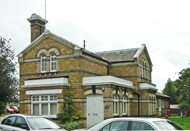
The Porter's Lodge of the former Hospital is now a Training Centre.
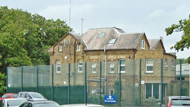
The former Nurses' Home has been converted into the Downview building, a closed prison for women.
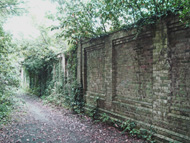
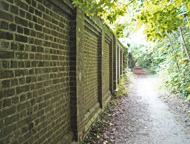
The old Asylum wall.
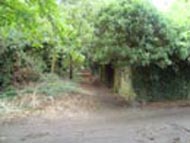
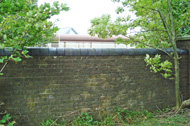
The southwest corner of the old Asylum wall (left). The prison fence and wall can be seen behind the Asylum wall.
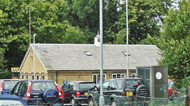
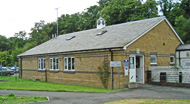
The Visitors' Centre.

The entrance to HMP High Down.
www.aim25.ac.uk
www.bansteadhistory.com
www.bscra.com
www.countyasylums.com
www.sochealth.co.uk
www5.surreycc.gov.uk
Return to home page